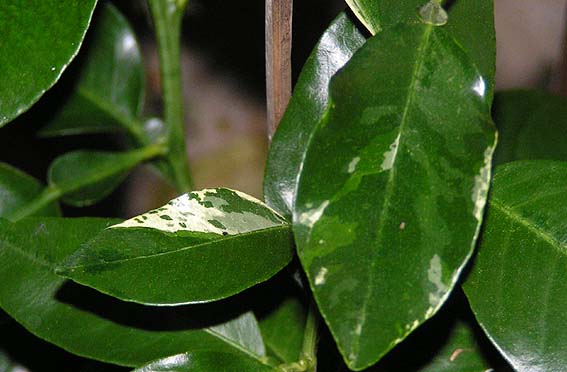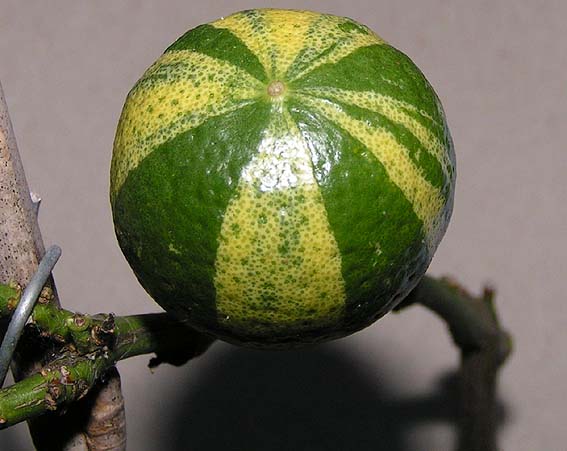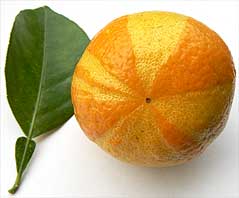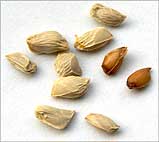| Author |
Message |
citrange
Site Admin


Joined: 24 Nov 2005
Posts: 590
Location: UK - 15 miles west of London
|
| Posted: Wed 30 Nov, 2005 6:43 pm |
|
I have two small potted plants of C. aurantium, which are old Italian ornamental varieties. They may be the same, but I was given budwood of 'Virgatum' and 'Fasciata'.
Virgatum has not yet fruited, but produces a few lightly variegated leaves.
Fasciata has so far normal leaves, but one very striped unripe orange, still only a couple of inches across.
Virgatum:

Fasciata:
 |
|
| Back to top |
|
 |
BabyBlue11371
Site Admin


Joined: 28 Nov 2005
Posts: 830
Location: SE Kansas
|
| Posted: Wed 30 Nov, 2005 7:23 pm |
|
BEAUTIFUL!!!! Now I see why the interest in Variegated...
Gina *BabyBlue* |
|
| Back to top |
|
 |
citrange
Site Admin


Joined: 24 Nov 2005
Posts: 590
Location: UK - 15 miles west of London
|
| Posted: Thu 21 Dec, 2006 7:33 am |
|
Over a year from my first post about this, I decided the fruit was ripe although still small - about 2" diameter.

What amazed me, and proved this really is a botanical chimera, was that the fruit contained two completely distinct types of seed

As usual, details are on my website at
Citrus aurantium 'Fasciata'
Mike aka Citrange |
|
| Back to top |
|
 |
garnetmoth
Citruholic


Joined: 28 Nov 2005
Posts: 440
Location: Cincinnati, OH
|
| Posted: Thu 21 Dec, 2006 11:20 am |
|
Hey Citrange that is really interesting!
Good luck with those seeds. |
|
| Back to top |
|
 |
Skeeter
Moderator

Joined: 23 Jul 2006
Posts: 2218
Location: Pensacola, FL zone 9
|
| Posted: Thu 21 Dec, 2006 2:02 pm |
|
Neat looking fruit! I wonder how does a chimera originate? Is it a fusion of a pollinated and nucellar seedling inside the seed or polination by 2 different grains of pollen?
Skeet |
|
| Back to top |
|
 |
BabyBlue11371
Site Admin


Joined: 28 Nov 2005
Posts: 830
Location: SE Kansas
|
| Posted: Thu 21 Dec, 2006 3:24 pm |
|
that is amazing there are two different types of seeds.. Will the seeds produce same as the parent or totaly different??
Will you be planting the seeds or sharing with friends?? 
Very beautiful!!! Inspired me to get my own varigated.. though my BUD (not more than that yet) is only a common V. pink lemon.. I still can't wait!!
I love browsing your pages!! great pics and info!!!
Thanks for posting pics!!!
Gina *BabyBlue*
_________________
 |
|
| Back to top |
|
 |
citrange
Site Admin


Joined: 24 Nov 2005
Posts: 590
Location: UK - 15 miles west of London
|
| Posted: Thu 21 Dec, 2006 6:11 pm |
|
I can't say I fully understand the genetics of these chimera - and I'm not sure the experts do either.
However, one type seems to originate from a single variety which has a mutation at a particular point which continues to grow alongside and maybe within the original. So, for instance, there might be a thread of material which cannot make the chlorophyll that turns leaves green. When this reaches the surface of a leaf it becomes variegated.
Much rarer - in fact I don't think any have been reported and studied in recent times - are the graft chimeras. Here it seems the two varieties, rootstock and scion, grow together as a single shoot. One variety or the other pops to the surface at random places. I have seen the really strange tree "+laburnocytisus Adamii" which is a graft chimera between completely different species Laburnum and Broom. Mostly a Laburnum with yellow flowers, but in places the purple broom appears.
No chimeras will reproduce a chimera from seed.
I think my Fasciata seeds will produce some plants of a normal Sour Orange, and some plants of Citron. I say this from the colour of the fruit, the look of the seeds and the fact that these species were commonly grown in Italy in past centuries.
A 'google' for "plant chimeras" or "citrus chimeras" will tell you more than I can.
Mike aka Citrange
PS. There are some completely false pictures of +Laburnocytisus on the web. Here is one:

The flowers are clearly grown only in Photoshop!
In reality the yellow flowers are rather short for a good Laburnum, and the purple Broom flowers are more a pinky brown!
Here is a more realistic photo:

M. |
|
| Back to top |
|
 |
snickles
Citrus Guru

Joined: 15 Dec 2005
Posts: 170
Location: San Joaquin Valley, Ca
|
| Posted: Fri 22 Dec, 2006 2:21 pm |
|
In your web site you mentioned you received some budwood.
What did you use for your rootstock? Were the plants from
which the budwood were taken from variegated and have you
made contact with the source to share notes on if your leaves
and fruit on your Fasciata is different from that of the parent
plant? Also, were the parent plants from which the budwood
came from budded or grafted trees themselves and if so what
rootstock parents did they have?
I know nothing of these two Citrus and you have some books
I've not ever had or read. I will agree that from what I am seeing
with the variegation in some of the Citrus that the cause of the
"chimera" coming about may be different than what I have seen
in other plants such as variegation to come about in Camellias,
Dogwoods and Japanese Maples. Of which to some of us it is
a virus already in the plant, not necessarily as a result of a two
parent chimera that is causing the variegation to come about.
Sectional chimeras in some Citrus fruit does seem to act and
appear differently than a virus caused or propagation induced
variegation in let's say a Camellia in which there is no random
pattern to the variegation in the flowers or the leaves. When
we see what I would call a vertical stripped pattern as opposed
to a mottled horizontal pattern in the chimera I tend to think
that a virus may or may not be affecting the variegation we are
seeing in the fruit itself. As far as the leaves and the variegation
we can see, there I do feel that a "color virus" is at work there but
that is just an assumption based on the what some people know of
the above mentioned plants. We can see variegated leaves in a
Hohman's Gold Dogwood yet the flower is white, not a red flower
with white mottling or pink with white and/or yellow stripes but an
all white flower which is the more common colored flower for
Dogwoods in general.
Several years ago when the Japanese saw a branch sport come
about on some of their palmatum type Maples and their Pinus
parviflora that showed variegation in the sport, they would allow
the sport to go to seed and then selected out seedlings that showed
the characteristics of the sport. Some of our Maples and Goyō Pine
cultivars came about in this manner. What we saw from the sport
had to also hold true in the offspring from non grafted plants before
the newly created form could be named and even then for years it
may have been called a name in the nursery, later named by someone
else that had a plant of it but to many people the seedlings from a
branch sport was considered a form of the original plant for a long
while. Until more recent years when several of those forms have
later been named themselves. As an example Ōsakazuki threw out
a branch sport in which a pink mottling showed up in the otherwise
green leaf. Seed was taken from the branch that sported, then seed
germinated on and then the seedlings that showed the pink mottled
coloring were saved and grown on for years to see if those plants
held true to the sport. After seven years at a minimum, more like
ten years and longer, then the offspring were considered a form
of the parent plant. Later on this form was called by those that had
it Beni ōsakazuki for their plant collections but did not consider it
a true cultivar thus they were hesitant to name it by committee but
was a form instead until someone that got some plants of it wanted
to sell it and then the name Beni ōsakazuki became known in some
circles in the nursery trade.
Jim |
|
| Back to top |
|
 |
citrange
Site Admin


Joined: 24 Nov 2005
Posts: 590
Location: UK - 15 miles west of London
|
| Posted: Fri 22 Dec, 2006 3:20 pm |
|
Interesting post Snickles, and it shows how complicated this subject is.
Just a few comments in reply.
I probably didn't make clear that this old Italian variety 'Fasciata' is grown because it does make these ornamental striped fruits. I didn't mean to suggest that I had created or discovered this chimera. I'm assuming it's probably a 'graft chimera' partly because of those different seeds. Surely, a simple genetic mutation somewhere in the plant might originally have caused the fruit to have different coloured stripes, but not also completely different seeds which I'm guessing will produce two different and stable citrus species.
Yes, there are viruses that produce variegation in plants. But the normal variegation seen in citrus cannot be transmitted. If you graft a normal top onto a variegated rootstock it does not become 'infected' with the variegation.
I've often wondered why citrus leaf variegation is fairly random in position on the leaf. Other plants show stable leaf-edge-only variegation for example, but this never seems to happen with citrus.
Mike. |
|
| Back to top |
|
 |
snickles
Citrus Guru

Joined: 15 Dec 2005
Posts: 170
Location: San Joaquin Valley, Ca
|
| Posted: Fri 22 Dec, 2006 6:00 pm |
|
Sometimes even grafting a variegated form onto a green rootstock
can impact the amount of variegation we will see in the scion plant.
We can even lose the variegation for a while, have it come back a
while later or we can lose the variegation altogether. We also have
seen a variegated branch sport develop years later from one of these
put together plants and then gathered seed from that sport and still
did not see any variegated seedlings.
Grafting a "green" form onto a variegated rootstock is no guarantee
that we will have a variegated plant now or perhaps later either. I
know what you mean here, even though I have not ever done it for
Citrus to see for myself to know. We have done it for other plants,
even to the point of selecting out a variegated rootstock to graft
variegated Maple cultivars onto. We "ran" with the notion that we
could induce more variegation into the scion plant which for us was
inconclusive, as even seedlings taken from the parent plant yielded
more non variegated seedlings than variegated ones. The seedlings
that were variegated held their variegation better than the parent
variegated scion plant seemed to for us in some cases. The non
variegated seedlings could later on develop some variegation but
in most cases it was slight. The experiment had mixed results for
us with Japanese Maples. Depending on the cultivar used that we
wanted to enhance, some offspring were better, some clearly better
but in others we did not improve things much.
I do not believe at this time that the chimera you are seeing in the
fruit is due to a virus. I am not sure of the leaves however as I do
see variance in the coloring of the leaves that makes me suspect
that the coloring I've seen is not random. I think what is random
is the prevalent coloring whether they are a bicolor, tricolor or
shades of coloring such as two shades of green, two shades of
yellow, one cream, one yellow in a two shaded green leaf. I
am not going to suggest anything as to what is causing these
types of variegation as I do not know for sure. It does seem
like a color virus could be at work here. We felt the virus was
a recessive trait once in the plants genome that the ability to
produce an even shade of green leaves was the more dominant
condition. Just like two parents with brown eyes can yield a
youngster with blue eyes. The recessive trait can come about
if those traits are already in their gene pool. Is it likely to
happen based on probability? No but we know it can happen
which in rather infrequent times, it does happen.
I am not sure if we all can agree on what a chimera is and what
causes it to happen. Is it possible for a rooted cutting from a
pure line plant to yield a chimera? In Japanese Maples a pure
line parent plant can yield a branch sport. It may not be frequent
and it may not happen for a number of years but it is possible.
Perhaps someone has a logical answer for us but we know we
cannot predict with certainty when a branch sport will come
about, even in plants that have a strong tendency to sport for
us.
Excellent topic citrange. Thank you for showing us the photos
of your plants. Hope to see more of them again later. Now, my
question is, will many or most of the fruit look like your Fasciata
does now and for how long will they remain the same or will we
see one or two principal sectional chimeras show up later on most
of the fruit as opposed to several that we now see on this fruit?
One thing about it, the markings we see on this Orange is flat out
gorgeous!
Jim |
|
| Back to top |
|
 |
Laaz
Site Owner


Joined: 12 Nov 2005
Posts: 5672
Location: Dorchester County, South Carolina
|
| Posted: Fri 22 Dec, 2006 8:12 pm |
|
Mike great plant you have there. A friend in Germany has many variations of variegated C.aurantium and many others. I believe you know him as well Mike ? From my experience jus about every variegated form of citrus will produce green bud sports. I remove them when they occur. There has been great debate as to whether the variegation is caused by a virus or a fungus...
http://albums.photo.epson.com/j/AlbumIndex?u=4214778&a=31258910&sp=1&showall=true |
|
| Back to top |
|
 |
snickles
Citrus Guru

Joined: 15 Dec 2005
Posts: 170
Location: San Joaquin Valley, Ca
|
| Posted: Sat 23 Dec, 2006 2:08 pm |
|
Below is a quick link to one of the known color breaking
viruses that affect Camellias. One of the people that helped
fund the mid 80's and earlier research was conceptual in
feeling that a similar "color virus" also affected other plants.
Who knows, variegated Citrus may be one of them. The hard
part is trying to control or have some control over the amount
of variegation we can see in the leaves and the amount of color
break we may see in the flowers. Some plants will show no
color break in the flowers but can or will have variegation in
the leaves
Camellia yellow mottle (?) varicosavirus
http://image.fs.uidaho.edu/vide/descr134.htm
Jim |
|
| Back to top |
|
 |
citrange
Site Admin


Joined: 24 Nov 2005
Posts: 590
Location: UK - 15 miles west of London
|
| Posted: Sun 24 Dec, 2006 11:51 am |
|
Laaz - Yes I correspond often with Dieter and we have exchanged many plants and budwood over the years. A couple of times when we have sent each other budwood, the original plant has died - to be resurrected by sending budwood back again in the other direction. Luckily, there are no restrictions on sending citrus material between England and Germany.
For more info on citrus chimeras, read the section in The Citrus Industry, VolII. Now on-line at
http://lib.ucr.edu/agnic/webber/Vol2/Chapter2_5.htm#chimeras
Mike aka Citrange |
|
| Back to top |
|
 |





























